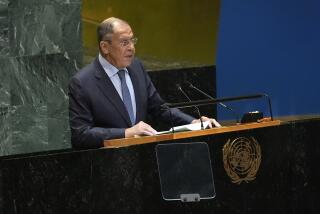Using Nukes to Keep Up Appearances
- Share via
Sometimes a world leader has to be drunk before he makes sense. Or maybe, as one Western diplomat said, Boris Yeltsin was merely “intoxicated by the atmosphere” of last week’s NATO summit when he suddenly announced that Russia would be removing nuclear warheads from its strategic missiles. What a panic there was in the ranks of those experts who have grown accustomed to equating security with the capacity for mass destruction.
Of course more sober counsel soon prevailed, and Yeltsin backtracked to say that what he really meant was that the warheads would stay on the missiles although not aimed at specific Western targets. That was most comforting because as long as the warheads remain on the missiles, they can be instantly retargeted and fired.
Whew, what a relief to know that the old Cold War nuclear war strategy of “use them or lose them” is still in force and with it the guarantee that 2,700 good old U.S. nuclear armed warheads would arrive in Russia at about the same time that 2,100 nasty Russian ones would destroy us.
Isn’t it reassuring that the damning complexities of modern international politics have not in the least intruded on nuclear policy-making? Let NATO welcome the former Soviet bloc countries to a new security arrangement while the Western powers continue to underwrite the new Russian economy. And why not supply the Russians with militarily useful high-tech equipment through joint ventures? Just as long as the collapse of the enemy superpower in no way vitiates the need for nuclear weapons.
Then again, nuclear weapons have not really been viable since Hiroshima demonstrated the inherently ghastly consequences of their use. Had the Soviets ever lobbed one at us, or vice versa, it would, as key experts on both sides reluctantly agreed, have been all over except for the radioactive rubble. Nuclear weapons proved irrelevant to the superpowers in their failed regional ventures, and the costly parity that the Soviets so desperately sought bankrupted and eventually destroyed their system. Nuclear bombs could not protect, and they could not feed. Anthropologists digging through the ruins of the old Soviet system will mark the rusted relics not as weapons but as icons of power and prestige worshiped with the reverence that earlier cultures had attended to their more primitive phallic symbols.
That is precisely why the hard-liners in Russia insist on preserving their nuclear arsenal. The Russian military is a disintegrating shell of its former self, unable even to impose its will after two years of battle on the ragtag Chechen resistance. But as long as the Russians possess a nuclear arsenal, there remains the illusion of power. As a result of this demented fixation, the START II arms control treaty remains stalled, and less progress has been made toward the elimination of the nuclear threat under democratic Russia than during the waning years of the old regime.
But the U.S. is hardly in a position to lecture the Russians or anyone else on zero tolerance for nuclear weapons. Not because we were the first to create and the only ones to ever use these instruments of mass horror, but more damnably that our fascination with them as proper weapons continues. Despite the end of the Cold War, and although strapped for cash, our government still spends $26 billion a year on the care and feeding of the nuclear arsenal. That’s more in constant dollars than we spent in 1980, when there was a formidable Soviet threat.
While we pledged throughout the arms control process to be opposed to the development of new generations of nuclear weapons, our practice has been quite the opposite, from the MX to “Star Wars.” Most recently, it was revealed that the Clinton administration, in clear violation of existing arms control agreements, has developed and secretly deployed the B-61, a new weapon for fighting a nuclear war. This is a sleek hydrogen bomb designed to burrow 50 feet into the ground and destroy fortified structures. If it is aimed at what remains of the command and control bunkers of the Russian force, then it is destabilizing and fuels the paranoia of Russian opponents of arms control.
More likely the B-61 is intended as a weapon against rogue nations like Libya or Iraq. Even so, it is an admission by the Clinton administration that it has not shunned the use of nuclear weapons and seriously weakens the effort to eliminate them from the world’s arsenal. The B-61 represents a continuation of the obsession to find a use for nuclear weapons that is consistent with the preservation of human values. There is none. Sober or not, Yeltsin was right.
More to Read
Sign up for Essential California
The most important California stories and recommendations in your inbox every morning.
You may occasionally receive promotional content from the Los Angeles Times.










